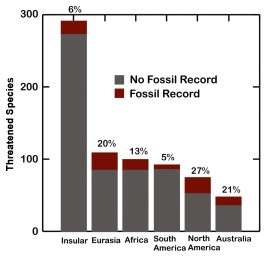Many species now going extinct may vanish without a fossil trace

Scientists struggle to compare the magnitude of Earth's ongoing sixth mass-extinction event with the five great die-offs of prehistory. A new study by three paleontologists shows that the species now perishing may vanish without a permanent trace - and earlier extinctions may be underestimated as well.
"Comparing the current biodiversity crisis, often called the 'sixth extinction,' with those of the geological past requires equivalent data," says Roy Plotnick, professor of earth and environmental sciences at the University of Illinois at Chicago.
He and two colleagues compared the "Red List" of endangered species with several ecological databases of living species and three paleontological databases of catalogued fossils. They ran a statistical analysis to indicate which threatened species were most likely to disappear with no mark of their existence.
The researchers were shocked to find that more than 85 percent of the mammal species at high risk of extinction lack a fossil record. Those at highest risk have about half the probability of being incorporated into the fossil record compared to those at lower risk.
Animals least likely to be found as fossils are "the small, cute and fuzzy ones, like rodents and bats," Plotnick said. "Body size is an obvious factor—bigger things tend to leave a fossil record, as do things with larger geographical ranges."
Viewed from the perspective of the fossil record alone, the magnitude of the current mammal die-off thus appears markedly reduced. The picture may be even more distorted for other land-dwelling vertebrates: only 3 percent of today's threatened bird species and 1.6 percent of threatened reptile species have a known fossil record.
Comparing the scale of the current extinction episode, which is based primarily on terrestrial vertebrates, to earlier extinctions that are mostly calculated from the fossil record of hard-shelled marine invertebrates, is particularly problematic, Plotnick said, although ancient extinctions may also be underestimated by contemporary paleontologists.
Nevertheless, fossils will provide the only reliable record of life on Earth for posterity.
"There are species going extinct today that have never been described," Plotnick said. "Others are going extinct that are known only because someone wrote it down." All such species would thus be unknown in the far future, he said, if the written historical record is lost—as it might well be.
The fossil record, Plotnick points out, is much more durable than any human record.
"As humanity has evolved, our methods of recording information have become ever more ephemeral," he said. "Clay tablets last longer than books. And who today can read an 8-inch floppy?" he shrugged. "If we put everything on electronic media, will those records exist in a million years? The fossils will."
More information: Roy E. Plotnick et al. The fossil record of the sixth extinction, Ecology Letters (2016). DOI: 10.1111/ele.12589
Journal information: Ecology Letters
Provided by University of Illinois at Chicago
















